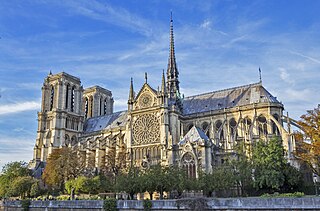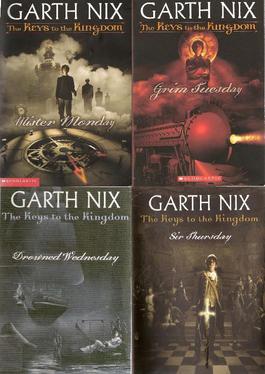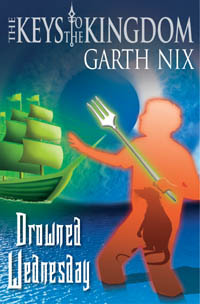
Gothic architecture is an architectural style that was prevalent in Europe from the late 12th to the 16th century, during the High and Late Middle Ages, surviving into the 17th and 18th centuries in some areas. It evolved from Romanesque architecture and was succeeded by Renaissance architecture. It originated in the Île-de-France and Picardy regions of northern France. The style at the time was sometimes known as opus Francigenum ; the term Gothic was first applied contemptuously during the later Renaissance, by those ambitious to revive the architecture of classical antiquity.

Notre-Dame de Paris, often referred to simply as Notre-Dame, is a medieval Catholic cathedral on the Île de la Cité, in the 4th arrondissement of Paris, France. The cathedral, dedicated to the Virgin Mary, is considered one of the finest examples of French Gothic architecture. Several attributes set it apart from the earlier Romanesque style, particularly its pioneering use of the rib vault and flying buttress, its enormous and colourful rose windows, and the naturalism and abundance of its sculptural decoration. Notre-Dame also stands out for its three pipe organs and its immense church bells.

The Tribune Tower is a 463-foot-tall (141 m), 36-floor neo-Gothic skyscraper located at 435 North Michigan Avenue in Chicago, Illinois, United States. The early 1920s international design competition for the tower became a historic event in 20th-century architecture. Built for Chicago Tribune owner Robert R. McCormick, since 2018 it has been converted into luxury residences and in 2023 won a Driehaus Prize for architectural preservation and adaptive reuse from Landmarks Illinois.

Chartres Cathedral, also known as the Cathedral of Our Lady of Chartres, is a Catholic Cathedral in Chartres, France, about 80 km southwest of Paris, and is the seat of the Bishop of Chartres. Mostly constructed between 1194 and 1220, it stands on the site of at least five cathedrals that have occupied the site since the Diocese of Chartres was formed as an episcopal see in the 4th century. It is one of the best-known and most influential examples of High Gothic and Classic Gothic architecture, It stands on Romanesque basements, while its north spire is more recent (1507–1513) and is built in the more ornate Flamboyant style.

A spire is a tall, slender, pointed structure on top of a roof of a building or tower, especially at the summit of church steeples. A spire may have a square, circular, or polygonal plan, with a roughly conical or pyramidal shape. Spires are typically made of stonework or brickwork, or else of timber structures with metal cladding, ceramic tiling, roof shingles, or slates on the exterior.

The Lord of the Rings Roleplaying Game, released by Decipher, Inc. in 2002, is a tabletop role-playing game set in the fictional world of Middle-earth created by J. R. R. Tolkien. The game is set in the years between The Hobbit and The Fellowship of the Ring, but may be run at any time from the First to Fourth Age and contains many examples of how to do so. Sourcebooks cover the events of The Lord of the Rings and Peter Jackson's film trilogy adaptation.

The flying buttress is a specific form of buttress composed of an arch that extends from the upper portion of a wall to a pier of great mass, in order to convey to the ground the lateral forces that push a wall outwards, which are forces that arise from vaulted ceilings of stone and from wind-loading on roofs.

The Keys to the Kingdom is a fantasy-adventure book series written by Garth Nix, comprising seven books published between 2003 and 2010. The series chronicles the adventures of a boy named Arthur, who becomes involved with a magical world called the 'House'; he is on a quest to take back the House from seven antagonistic 'Trustees'.

Rouen Cathedral is a Catholic church in Rouen, Normandy, France. It is the see of the Archbishop of Rouen, Primate of Normandy. It is famous for its three towers, each in a different style. The cathedral, built and rebuilt over a period of more than eight hundred years, has features from Early Gothic to late Flamboyant and Renaissance architecture. It also has a place in art history as the subject of a series of impressionist paintings by Claude Monet, and in architecture history as from 1876 to 1880, it was the tallest building in the world.

Raven is a BBC Scotland children's adventure game show. It originally aired on CBBC in the United Kingdom from 16 December 2002 to 11 March 2010, over the course of ten series, with three spin-offs. In the original release, the show was hosted by James Mackenzie who played the title role, and conducted a group of six children, known as warriors, over five days through a series of tasks and feats. At various stages in the adventure, the group loses the least successful warrior, until two go through to the final week to compete for the title of Ultimate Warrior.

Drowned Wednesday is the third book in The Keys to the Kingdom series by Garth Nix. It continues the story of Arthur Pehaligon and his quest to fulfil a mysterious Will in order to reclaim an otherworldly House from seven antagonistic Trustees. Following the events of the previous novel, Arthur must secure the third part of the Will from a fiendish pirate in order to save the Border Sea from Drowned Wednesday's insatiable appetite.

Lady Friday is the fifth novel by Garth Nix in his The Keys to the Kingdom series.

Mister Monday is the first novel in the series The Keys to the Kingdom by Garth Nix. It follows Arthur Penhaligon, a twelve-year-old boy who discovers that he is the heir to an otherworldly House and must fulfil a mysterious Will in order to claim it from seven antagonistic Trustees.

Sir Thursday is a young adult fantasy novel written by Australian author Garth Nix. It is the fourth book in the series The Keys to the Kingdom, and was released in March 2006. Sir Thursday continues from the preceding book, following the adventures of a boy named Arthur as he attempts to claim mastership of the fourth part of a magical world. As with the other books in the series, the theme of 'seven' is prevalent, along with the themes of sin and virtue. The book received generally favourable critical response, but was criticised for a slow pace, among other issues.

St. George's Cathedral is an Anglican cathedral in Georgetown, Guyana. The church is of Gothic revival timber construction and reaches a height of 43.5 metres (143 ft). It is the seat of the Bishop of Guyana.

Superior Saturday is the sixth novel by Garth Nix in his The Keys to the Kingdom series. It tells part of the story of a boy named Arthur as he tries to gain control of a magical world.

Lord Sunday is the seventh book concluding Garth Nix's The Keys to the Kingdom series. It tells the last part of the adventures of a boy named Arthur in his quest to take back a magical world.

French architecture consists of architectural styles that either originated in France or elsewhere and were developed within the territories of France.

French Gothic architecture is an architectural style which emerged in France in 1140, and was dominant until the mid-16th century. The most notable examples are the great Gothic cathedrals of France, including Notre-Dame Cathedral, Reims Cathedral, Chartres Cathedral, and Amiens Cathedral. Its main characteristics are verticality, or height, and the use of the rib vault and flying buttresses and other architectural innovations to distribute the weight of the stone structures to supports on the outside, allowing unprecedented height and volume. The new techniques also permitted the addition of larger windows, including enormous stained glass windows, which fill the cathedrals with light.

Japeth Paul Cabrera Aguilar is a Filipino professional basketball player for the Barangay Ginebra San Miguel of the Philippine Basketball Association (PBA). He first played college basketball for the Ateneo Blue Eagles of the University Athletic Association of the Philippines (UAAP), but after two seasons, he moved to the Western Kentucky University Hilltoppers in the Division I of the National Collegiate Athletic Association in the United States.



















